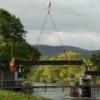The structure was unveiled by Dar and Autodesk Research at Autodesk University 2022.
It is the latest outcome of a research project that has focused on using generative design, 3D printing, robotics and artificial intelligence to improve the construction industry. Aims include making the industry safer, more sustainable, more intelligent and more efficient.
The latest bridge follows an earlier 2m-long structure. The larger structure has enabled the research team to experiment with improved printing practices and recycled materials, test the possibility of printing in-situ with robots on construction sites and refine the process of creating intelligent infrastructure.
The single-propped cantilevered bridge was 3D-printed using recycled polyethylene terephthalate glycol (PETG) and glass fibre, with fibre Bragg grating (FBG) sensors integrated into the deck and traditional strain gauges in the support.

Dar and Autodesk Research drew on lessons learned from the experience of printing and designing the 2m bridge to optimise the available design and printing strategies. In one of the key adjustments, the 5m bridge was printed at an angle, as opposed to the horizontal approach adopted for the 2m structure. The team said that printing at an angle offers much more flexibility by eliminating the constraint of the limited overhang angle and by ruling out the need for support material. Moreover, printing at an angle reduces the time needed to print a single layer and makes it easier to print in-situ on construction sites, opening up more opportunities for printing structural elements and parts with larger footprints, they added.
The 5m bridge also features a more complex design. While the first bridge was designed mainly as a hollow structure, the 4m bridge used an infill that mimics bone structure and functions as a lattice assembly. In designing this internal structure, the team compared different infill patterns based on added weight, gained stiffness and printing speed in order to find a pattern that best balances the combination of these criteria. The infill, which is used in medical implants, is remarkably easy to print and offers greater flexibility in various directions, said the team.
Generative design was used to create the optimal external organic shape of the bridge and parametric design was used to optimise the infill pattern in terms of volume percentage and bead width, with the intent of maximising stiffness and minimising additional weight.
Information from the sensors is transmitted to and represented on a digital twin platform, which conveys the bridge condition in real time.



